The problem of choosing a foundation for structures exists in difficult geological conditions. It is rational to use the pile-grillage foundation, which assumes 20% of the cost of construction. The underground part of the hanging rods increases the bearing capacity of the soil and ensures the reliability of the structure. Reconstruction of a low-quality foundation requires additional investments, therefore, appropriate design is an urgent direction.
- Definition of pile-grillage foundation
- Pile selection
- Types of pile-grillage foundation
- By the method of immersion in the ground
- By the degree of depth
- Construction technology
- The process and stages of pouring the grillage
- Carrying out work on insulation of the foundation
- Possible mistakes
- Pros and cons of pile-grillage foundation
Definition of pile-grillage foundation
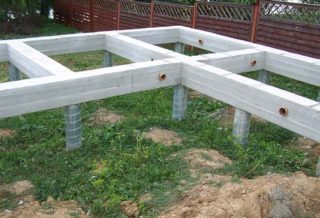
The structure is used for the construction of buildings on unstable soils or in the case of the construction of a large-sized structure. Piles with a pointed end are used as the base, each of them withstands a force of 2 - 5 tons. The top of the rods is united by a beam or slab belt, which is called a grillage. The harness is applied under the load-bearing walls and is placed around the perimeter of the house.
To determine the number of hanging elements, a calculation is made that requires characteristics:
- the weight of the building with equipment, people, snow and wind loads;
- technical indicators of the soil at the construction site.
The grillage distributes static forces evenly and binds the vertical rods so that they do not move under load. Piles are made of metal or reinforced concrete, and metal profiles, concrete, wooden blocks are taken for the connecting beams.
In private housing construction, the foundation grillage on piles is rarely used because of the large cost part. The use of such a structure is justified if the house is being built in a swampy area or on soils belonging to the category of quicksands.
Pile selection
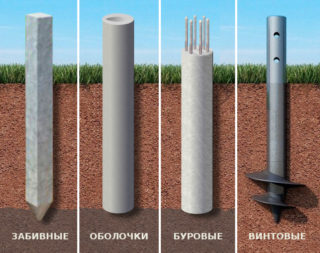
The length of the pile, the diameter depends on the load, the resistance of the soil layer and is assigned so that the element is located outside the zone of soil freezing. The length of the well depends on the capabilities of the drilling equipment. The bottom of the grillage is determined by the presence of a technical subfloor, basement, relief of the land plot.
The pile foundation project is based on the results of engineering developments, information on the seismicity of the area. When choosing a technology, environmental requirements are taken into account and the economic options for other solutions are compared. The calculation rules are given in the normative document SNiP 11.В.1 - 62.
In the plan, piles are placed with a constant or variable pitch, which is previously indicated in the drawing. Hanging elements and grillage are calculated according to deformations with the condition that the structure settles down by an amount less than the standard indicator. The method allows you to determine the profitability of the grillage base before the installation of a monolithic strip foundation, a solid concrete slab.
Types of pile-grillage foundation
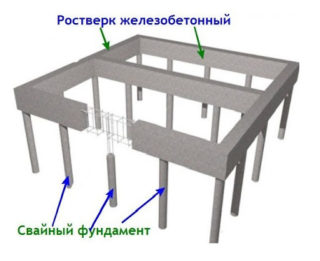
Weak soils are pierced with the tip of the rod until it stops in stable soil, which are coarse, rocky layers and hard clayey rocks. The length of the vertical sheet pile can be up to 20 meters.
A pile foundation with a grillage is subdivided according to the characteristics:
- material - there are reinforced concrete, wooden, steel and concrete options;
- method of immersion in the ground - they are classified as driven, vibro-immersed, screw;
- soil handling - hanging structures distribute the load using friction, and the struts transfer forces directly to the stable rock.
The section of the grooves is square, polygonal, tubular. The elements are made of composite, one-piece, screw, with expansion. Monolithic structures have a cylindrical cavity inside, they are one-piece with a constant length. Prefabricated options are connected from reinforced concrete blocks and recruited to the required length.
By the method of immersion in the ground
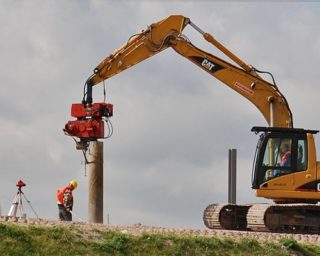
Driven piles are driven by percussion equipment. The tip displaces soil particles to the side, upward when deepening and penetrates into the ground. The rod drives out the soil volume equal to the volume of the submerged area and additionally compresses the base. Diesel and rod hammers are used at the construction site.
The vibration method reduces friction in the soil and on the side area of the submerged element. An effort is required, which is several times less than with the impact method. The earth is compacted at a distance of 1.5 - 3 pile diameters from its body. Electromechanical vibratory drivers are used, which, with the help of the pulsation amplitude and the mass of the pile, break the soil structure.
Screwing together with pressure is carried out for reinforced concrete and steel piles using automotive installations. Vertical elements have a tip with a helical blade, a barrel, a guide and an extension. They are used for reconstruction and repair of foundations and for construction in permafrost regions, on heaving, watered soils.
By the degree of depth
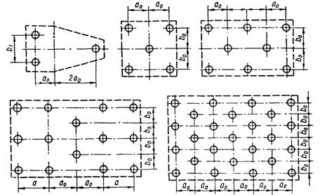
Hanging grillage works in an environment of compressing soils, distributes the load using the force of lateral friction, the resistance of the tip. Such elements cannot be deepened to a stable formation, and this is their disadvantage. For reliability, the area of the heel of the guide part increases and a larger number of elements are placed on the site.
An increase in size leads to a rise in the cost of the foundation structure, an increase in labor intensity. A large amount will pull weight and additional draft. Reducing the distance between the hanging rods sometimes saves the day.
The racks have a tip that transfers the force to the incompressible layers; such rods do not lead to shrinkage of the structure. Rack grooves are used to strengthen the foundation when laying communications, pipelines, railway lines, since they have a high coefficient of shear resistance. In the city, they are erected as supports for walls and for the construction of industrial units with heavy equipment.
Construction technology
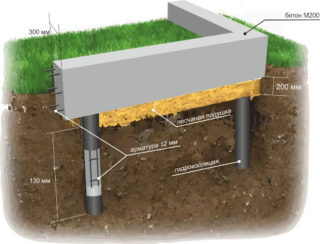
The boreholes are deepened with hand drills, whereby a diameter of 100-200 mm is drilled, and the length is limited by a distance of 1 m. Motorized, hydraulic and electric machines increase the lateral dimension of the borehole and the length of the passage up to three meters. Grillages for pile foundations require a sand and crushed stone layer with a thickness of 15 - 20 cm.
The composition of the bedding is allowed:
- fine crushed stone, sand - 1: 2, respectively;
- coarse sand, gravel of medium fraction - 2: 3, respectively.
The number of vertical rods is taken by calculation, but if there is none, the margin of safety of the base is taken, the piles are located with a minimum step of 1 m. The centers of the rods coincide with the axes of the house breakdown, the diameter of the piles can be 170 - 400 mm. For reinforcement, welded or knitted frames with ribbed reinforcement with a diameter of over 12 mm are used. Longitudinal rods should be made of A-3 class metal, and A-1 should be placed in the transverse direction.
The process and stages of pouring the grillage
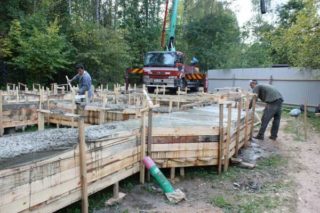
Sealing of reinforcing outlets and rigid connection of the grillage with piles is ensured in case of weak soils and lateral loading on the building. The ends are folded over and attached to the grillage frame using a knitting wire. The grillage is poured in layers, up to 25 cm is concreted in one step. An electric vibrator is used to expel air bubbles from the mass. Concrete gains 100% strength after 28 days, only after that it is loaded and a grillage is placed.
Step-by-step instructions for correct filling:
- fill the formwork by a third;
- the automixer pipe is raised so that some of it falls to the bottom;
- the leaked mass is pressed to the ground to form a rigid support platform;
- fittings are inserted so that the top does not protrude above the level of the pipe;
- a threaded rod is placed in the upper part of the concrete for joining with the grillage, the element protrudes by 30 cm.
It is better to continuously pour the formwork with a break for compaction of the layers. If you dig a trench along the width of the grillage, no formwork is needed, concrete can be poured directly into the ground.
Carrying out work on insulation of the foundation

Reinforced concrete grillage becomes a cold bridge, regardless of its location at ground level. The structure draws heat away from the walls that are erected directly on it. Insulation works similarly to the insulation of a strip base and protects the grillage itself from energy losses.
A wooden or metal beam leaves a wind-blown space under the house. The gap is closed with insulation to save on heating the house. Sewerage, water supply is also laid in this space, and thermal insulation protects against freezing of water and drains.
Debris and leaves get into the open space under the building, which will require additional cleaning. The closed and beautifully finished lower part looks attractive and adorns the façade. Insulation of the basement is done simultaneously with the creation of an isolated blind area outside along the perimeter of the walls. Thermal insulation options depend on the height of the basement part, the features of the grillage.
Possible mistakes
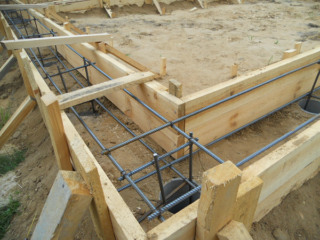
It is better to entrust the installation of piles with a grillage to specialists or work according to a drawing and only after a technical calculation. Violation of technology will lead to subsidence and destruction of the house.
Typical errors:
- lack of verticality when deepening the pile;
- use of pits when tightening screw rods;
- installation so that the pile touches the solid foundation, but should go into it by 0.2 - 0.3 m;
- violation of the technical plan for the placement of elements;
- ignoring metal heads on the top of the pile;
- using holes from old piles for installing new ones.
Tilted rods reduce the bearing capacity of the foundation; over time, such elements can be pulled out of the ground. The piles should be rolled into the ground, starting from the surface of the ground. The cavity of the element is concreted after hammering and is limited by a headguard that protects against moisture.
Pros and cons of pile-grillage foundation
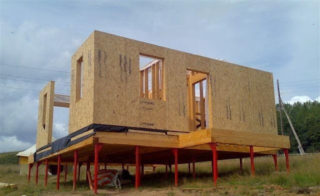
The device requires fewer materials than for the manufacture of a solid monolithic slab, while any deepening is chosen, it is possible to build on shaky soil or in permafrost conditions. The small volume of excavated soil does not require the use of an excavator, and the screw piles are driven by a drill.
Technological features make it possible to reduce the cost of a pile foundation to a similar indicator for a strip foundation while demonstrating high strength characteristics. Reducing labor intensity leads to the fact that the complex of works, together with insulation, is performed by a team of specialists consisting of three people.
The disadvantage of a pile foundation with a grillage is that it is difficult to build a basement or basement in such houses. For their construction, an additional set of work is required to seal the space with warm walls, which increases the cost of construction.
The technology assumes exact observance of the ratio of concrete components and grades of constituent materials to prevent the rod breaking under lateral soil pressure.








